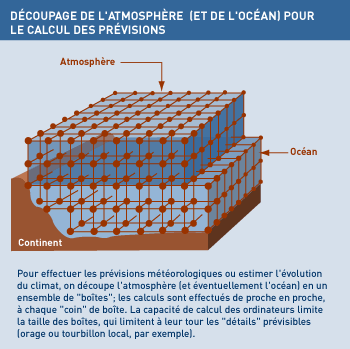Polar Encyclopædia
WEATHER FORECASTING AND MODELING
WHAT’S THE WEATHER TOMORROW ?
Meteorologists are getting better and better at answering this question, but forecasting more than 5 days ahead is still very uncertain. This is because the Earth’s climate is such a complex overall system: each cloud, each storm, each plot of farmland, each built-up area, each ocean current (even down deep) and each stretch of polar pack ice affects our climate. And no-one can know what’s going on all over the globe, from pole to Equator… It is possible to forecast seasonal trends, but no-one can say what the weather will be like in 2 weeks time on a particular beach.
A WORLDWIDE OBSERVATION NETWORK
Dotted across all the continents on Earth there is a network of thousands of weather observation stations recording measurements such as temperature, wind speed, pressure, humidity, etc. Aircraft and weather balloons are used to take measurements at altitude, while ships and weather buoys send back the same data, plus information on ocean currents. All this data is fed into computers used to draw up weather forecasts.
WEATHER SATELLITES TOO
Even out in space, weather satellites orbit the Earth in mobile and geo-stationary satellites orbit (geo-stationary satellites orbit at the same speed as the Earth’s rotation, so they remain above a fixed spot) the globe sending back real-time images of atmospheric conditions. This constantly updated overall picture, combined with data from surface facilities, has been a big factor in improving weather forecasting.

MORE RELIABLE WEATHER MODELS
The computers used by meteorologists draw up forecasts according to predetermined methods and using parameters already implanted in their memory. In order to simulate the circulation of the various earthly fluids, the atmosphere and the oceans are cut up into compartments and the computer calculates the impact of each one on the adjacent compartments. But when calculating forecasts several hours ahead, any variation in the initial stages can produce a totally different result. The only solution here is to fine-tune the compartments to factor in the influence of landscape relief, living organisms etc., and to develop even more powerful “number-crunchers”.
Support the project with a donation
The Polar POD expedition is one of the stamp of the pioners, a human adventure coupled with a technological challenge, an oceanographic exploration never before carried out which will mark a milestone in the discovery of the oceans.
Thank you for your support !